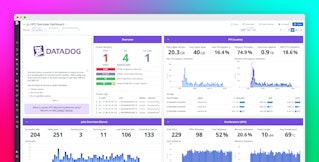
Candace Shamieh

Patrick Krieger

Colby Hanley
As organizations increasingly adopt multi-cloud strategies, identifying areas to reduce cloud spend has become highly complex and time consuming. While there are many reasons that organizations choose to run their infrastructure in a multi-cloud environment, many do so to comply with regional data requirements, take advantage of best-of-breed offerings, or avoid vendor lock-in. With infrastructure spanning across AWS, Azure, and Google Cloud, organizations need to be able to understand which actions they can take that will result in the most cost savings.
During our research for the State of Cloud Costs inaugural report, we found that more than 80% of container spend is wasted on idle resources and the percentage of organizations participating in commitment-based discounts is decreasing. These findings suggest that identifying and implementing ways to optimize cloud costs is more urgent than ever. To help you reduce unnecessary cloud spend and rightsize your resources in a multi-cloud environment, we’re proud to announce that Cost Recommendations, a feature of Datadog Cloud Cost Management, now offers cost-savings guidance for your AWS, Azure, and Google Cloud environments.
Cloud Cost Recommendations highlights actions you can take to eliminate waste and optimize cloud resources so you can align spend with business priorities. Using both billing and observability data, Cost Recommendations identifies tangible steps that reduce costs. It also includes native workflows for each cloud provider, enabling you to perform high-impact actions, like rightsizing Amazon EBS volumes, without leaving the Datadog UI.
In this post, we’ll discuss how Cost Recommendations provides you with:
- Actionable insights that enable you to optimize costs for your resources running in AWS, Azure, and Google Cloud
- Customized recommendations that align with your organization’s specific goals
- Built-in workflows that help you implement cost-saving insights directly from Datadog’s UI
Find cost optimization opportunities specific to your multi-cloud environment
Cost Recommendations gives you a unified view of your cloud spend across AWS, Azure, and Google Cloud, enabling you to identify opportunities for cost savings without switching tools. On the landing page, you can review the top recommendations that will help you realize the most cost savings, the amounts you can save monthly and annually, and a donut chart that visualizes each recommended action with your projected savings.

Cost Recommendations analyzes your specific environment and highlights idle or underutilized resources so you can optimize for cost efficiency while maintaining performance. It also detects where you’re using previous-generation technologies, prompting you to modernize and spend less. For example, Cost Recommendations reveals where you’re still using Amazon EBS gp2 volumes so you can migrate to gp3, which cost 20% less. With the ability to filter by cloud provider, resource type, recommendation type, or tag, you can home in on the most impactful savings opportunities for your organization.

Here are a few examples of the types of recommendations you’ll receive:
- In your AWS environment, Cost Recommendations detects when a Lambda function has exceeded its allocated level of provisioned concurrency, if you’re using previous-generation EBS volumes or noncurrent versions of S3 objects, and prompts you to delete unnecessary load balancers or trails.
- For your Azure environment, Cost Recommendations notifies you of opportunities to reduce the replica count in your Azure Container Apps, scale down VMs, terminate idle VMs, and delete unattached managed disks.
- For your Google Cloud environment, Cost Recommendations identifies when you should resize the machine type of a Compute Engine instance, create a resize request in your managed instance group (MIG), and whether you’ll benefit from enabling Autoclass for your buckets.
If you’re using Kubernetes in your multi-cloud environment, Cost Recommendations reports whether you could reduce costs by using autoscaling or resizing the resources assigned to your containers.

Cost Recommendations consistently analyzes your billing and observability data and refreshes recommendations daily. Because each recommendation is specific to your environment, you no longer have to perform the time-intensive work of figuring out how to manage cloud spend in a multi-cloud environment.
Adapt recommendations to your organization’s needs
Cost Recommendations helps you understand how and where you’re spending in a multi-cloud environment, so you can ensure that costs align with business goals. For an even more tailored experience, you can customize recommendations. Customizing recommendations verifies that your organization’s unique needs are accounted for before a recommendation is generated. You can configure custom metric thresholds, evaluation time frames, and control how rules are applied.
Custom metric thresholds help you determine when it’s worth it for your organization to rightsize a resource. For example, the recommendation to downsize your Azure SQL Database DTU will trigger if usage is less than 20%. But if it’s normal for your organization to experience unpredictable spikes in demand, then it might not be advisable to downsize unless DTU usage is less than 10% to avoid compromising performance.
By adjusting evaluation time frames, you can calibrate recommendations to coincide with your organization’s seasonal and operational baselines. You can choose whether custom metric thresholds and evaluation time frames apply to all resources or only to resources with specific tags. Furthermore, you have the flexibility to update the parameters of your custom recommendations at any time.

Exercising control over metric thresholds, evaluation time frames, and tag-based rule application ensures that recommendations remain relevant to your multi-cloud environment.
Act on insights without switching tools
Once you’ve identified opportunities for cost optimization, you can use Datadog Native Actions, our enhanced integration with Jira, and Datadog Case Management to take practical steps toward implementing recommendations.
Powered by Workflow Automation, Datadog Native Actions enables you to make quick changes to your cloud resources directly from Datadog’s UI. For example, you can delete orphaned EBS volumes or migrate from gp2 to gp3 in just a few clicks. These out-of-the-box actions accelerate remediation and eliminate the need for manual scripting or console hopping.

The Jira integration makes it easy for engineers to collaborate with FinOps analysts. Directly from the Recommendations list page, you can quickly create Jira issues, bulk add recommendations to a single Jira ticket, and track the status of linked Jira tickets. You can also view the details of any associated tickets in the side panel. All Jira tickets created will automatically be tagged with cloud-cost-recommendation for easier filtering and reporting.

For further collaboration, you have the ability to create a case in one click within the side panel of a recommendation.

By using Case Management, you can track the implementation of a recommendation at a granular level, including an activity timeline, assigned owners, and any related metrics or alerts that might indicate an emerging pattern. This provides end-to-end visibility into how recommendations are being evaluated and implemented, and can help you document results.
Gain insight into cloud spend in a multi-cloud environment
Cost Recommendations enables you to optimize your cloud resources for cost savings without compromising performance. With Cost Recommendations, you have the ability to manage cloud spend across AWS, Azure, and Google Cloud from a centralized location and can use Datadog Native Actions to quickly implement recommendations in a few simple clicks. You can always customize recommendations to align with business needs and use our expanded Jira integration and Datadog Case Management to ensure easy collaboration between engineering and FinOps. Ultimately, Cost Recommendations helps you prioritize implementing the most high-impact recommendations, which translates into significant cost savings for your organization.
To learn more about Cost Recommendations, visit our documentation. You’ll start to receive recommendations for your AWS, Azure, and Google Cloud environments after setup. If you’re new to Datadog and want us to be a part of your monitoring strategy, you can get started now with a 14-day free trial.





